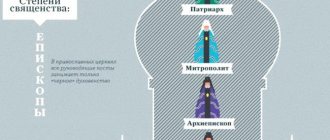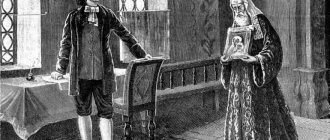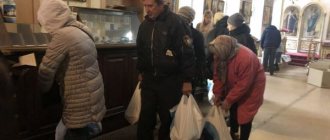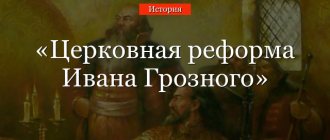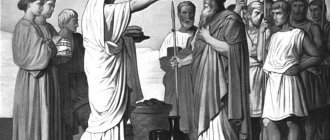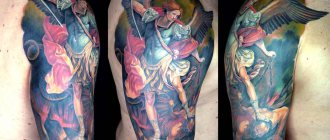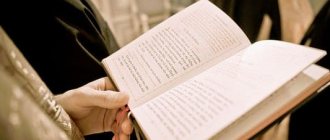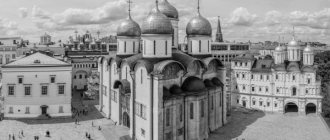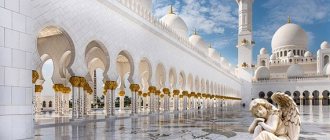The choice of faith today is a personal matter for everyone. Now the church is completely separated from the state, but a completely different situation developed in the Middle Ages. In those days, the well-being of both an individual and society as a whole depended on the church. Even then, groups of people were formed who knew more than others and could convince and lead. They interpreted the will of God, which is why they were respected and sought advice. What is the clergy? What was the clergy of the Middle Ages like, and what was its hierarchy?
Definition of the word “Clergy” according to TSB:
Clergy - in modern religions, ministers of worship, usually (but not in all religions) organized in a hierarchical corporation. Representatives of D. are revered by believers as people endowed with supernatural power, capable of being mediators between people and God. Depending on its position and function in the church, D. is divided into higher and lower. In some religions, representatives of the highest religion are revered as God's representatives on earth (the Pope in Catholicism) or as the incarnation of a deity (the Dalai Lama and the Panchen Lama in Lamaism, the head of the Ismaili sect). In a number of religions, monasticism is divided into black (monasticism, which takes on special obligations, including leaving “from the world”) and white (living “in the world”). In Buddhism, monasticism embraces everything. In an antagonistic class society, democracy for the most part was and is the support of the ruling exploiting classes. “All and every oppressing class needs two social functions to protect its dominance: the function of the executioner and the function of the priest. The executioner must suppress the protest and indignation of the oppressed. The priest must console the oppressed, draw to them the prospects ... of mitigating disasters and victims while maintaining class rule, and thereby reconcile them with this rule, discourage them from revolutionary actions, undermine their revolutionary mood, destroy revolutionary determination" (Lenin V.I., Complete collected works, 5th ed., vol. 26, p. 237). It is generally accepted to associate D. with monotheistic religions. Its immediate predecessor was the Priesthood, typical of polytheism (an earlier stage in the development of religion). There is no fundamental difference between D. and the priesthood. One of the main functions of the priesthood of the states of the ancient world was the practice of religious worship. the priesthood was a privileged stratum that was part of the ruling class. The process of the formation of D. and the beginning of the formation of the church hierarchy can be traced through the example of Christianity. In the early Christian communities, organized democratically, D. did not yet exist. With the increase in the number of supporters of Christianity, a division occurred in communities into clergy (clergy) and laity. From approximately the middle of the 2nd century. leadership in the communities gradually passed to the bishops, to whom the clergy were subordinate, and at the beginning of the 4th century. Monasticism arose. Later, the bishops of the most influential bishoprics began to be called patriarchs, and the Papacy was formed on the basis of the Roman episcopate (5th century). In feudal states, the D. constituted a special privileged class that guarded the interests of the feudal lords and sanctified the feudal exploitation of the people. Members of the highest spiritual hierarchy (archbishops, bishops, abbots of monasteries, etc.) were large landowners, and the masses of feudal-dependent peasants were brutally oppressed on their lands. Although D., being in the Middle Ages “... the only educated class” (F. Engels, see K. Marx and F. Engels, Soch., 2nd ed., vol. 21, p. 495), contributed to some spread of literacy , knowledge (founded schools, copied books in monasteries, compiled chronicles, etc.), but at the same time it hindered the development of science, independent of theology, seizing a monopoly on education, subordinating the entire spiritual life of society to its influence. Individual representatives of D., who rose above their circle and acted as carriers of progressive thought (J. Bruno), were subject to persecution. The lower classes, recruited from among the burghers, peasants and plebeians, were closer in living conditions to the masses. People from its ranks were often participants or leaders of popular movements (J. Ball, Dolcino, Jan Hus, etc.), and sometimes criticized religion, the church and social order (J. Meslier, J. Roux). Under capitalism, the former political and economic ties of the highest democracy with the landowning aristocracy are gradually replaced by ties with the big bourgeoisie, with monopolies, whose interests the democracy (for the most part) defends, proclaiming the sacredness of private property, justifying the class division of society and condemning the revolutionary class struggle. During the era of imperialism, D. began to actively participate in the struggle of the bourgeoisie against the socialist labor movement. After the victory of the Great October Revolution, which was greeted with hostility both in Russia and abroad, as a rule, anti-Sovietism and anti-communism became one of the constant motives in the social and religious activities of most of the democratic (especially higher) capitalist countries. A large place in the activities of the D. of bourgeois states is occupied by the propaganda of religious doctrines among the population, while it uses various political parties and organizations for its own purposes. The strengthening of the world socialist system, the successes of the national liberation movement, and the popularity of the ideas of socialism led many representatives of democracy in various countries to realize the need to reconsider their positions on the most important issues of our time: namely, to abandon the unconditional justification of capitalism. Part of D. began to support the movement for peace and peaceful coexistence. In socialist countries, the strengthening of the socialist system prompted the bulk of D. to take a loyal position in relation to the socialist state. D. remains a preacher of anti-scientific idealistic ideology. To counter the influence of the ideas of communism and the decline of religiosity, D. began to look for new ways to influence the masses. One of these ways is, for example, the organization by the Catholic Church of the so-called secular apostolate - the creation of lay apostles. Representatives of D., in order to strengthen the position of religion, shaken by the development of science, try to idealistically interpret scientific discoveries. In an effort to maintain his influence on the masses, D. presents himself as a guardian of national identity and culture, dissociates himself from the dark pages of his distant and recent past, and exalts his role in history. M. M. Sheinman. D. in Russia. On the territory of the Russian state, and later the Russian Empire, there were many religious cults and denominations. The most important of them were: in the Christian religion - the Russian Orthodox Church, the Armenian Apostolic Church, the Georgian Orthodox Church, the Catholic Church, the Lutheran Churches, and the Old Believers. as well as Islam, which has followers of Sunni and Shiite traditions. Judaism, divided into Talmudists and Karaites. Buddhism, whose followers profess its Lamaistic variety. many sects - Molokans, Doukhobors, Mormons, Stundists, Khlysty, Baptists, Evangelical Christians, Adventists, etc. In many religions in Russia, D. is a closed class with a strict hierarchy. From top to bottom, this hierarchy looks like this: in the Orthodox Church there are 3 degrees of priesthood: bishop (patriarch, metropolitan, archbishop, bishop). presbyter (protopresbyter, archpriest, priest), and in monasticism - archimandrite, abbot, hieromonk. deacon (protodeacon, deacon), and in monasticism - archdeacon, hierodeacon. In the Old Believer Church of Belokrinitsky and Beglopopovsky consent there is an archbishop (head of the church), bishop, archpriest, priest, protodeacon, deacon. in the Old Believer Church of non-priest consent - a mentor. In the Catholic Church - archbishop, bishop, dean, provost (rector), priest, deacon, subdeacon. In Protestant religions, which do not have a church hierarchy, D. is elected by believers and has: in the Lutheran Church - archbishops, bishops, provosts, senior pastors, and pastors. In religious sects - senior elders, evangelists, presbyters, preachers, deacons. In the Jewish religion - rabbis. in the Buddhist religion - hambo-lam, lam. in religious sects - senior elders, evangelists, deacons, presbyters, preachers. At the head of the Russian Orthodox Church is the Patriarch, at the head of the Armenian Apostolic Church is the Supreme Patriarch-Catholicos of all Armenians, and at the head of the Georgian Orthodox Church is the Patriarch-Catholicos. Lutherans reject complex church hierarchy and monasticism. The Estonian and Latvian Lutheran churches are each headed by their own archbishop, elected by the communities of believers. At the head of each church community is a pastor invited by it, who is considered not as a mediator between God and believers, but only as an interpreter of the Holy Scriptures. In the Jewish religion, rabbis play approximately the same role as experts and interpreters of sacred texts and leaders of the religious community. In Islam, a mufti stands above ordinary clergy (mullahs). The Transbaikal Buddhists are led by Bandido Hambo Lama. The dominant church in Russia was the Russian Orthodox Church. In 1897 out of 126368 thousand people. about 80 million of the Russian population were Orthodox. Both types of clergy - black (monks) and white (priests, archpriests, deacons and protodeacons) - appeared in Rus' after the adoption of Christianity (988-989). Since Christianity was borrowed from Byzantium, at first, as a rule, the clergy were Greeks. At the same time, the church hierarchy was created. The head of the Russian church is the metropolitan, appointed by the Patriarch of Constantinople. At the head of individual dioceses (church districts) were bishops and archbishops, elected from among the black D. by the metropolitan and a council of Russian bishops with the significant participation of secular authorities (princes). Since 1448, the Russian Church freed itself from subordination to the Patriarch of Constantinople and became independent (see Orthodox Church). The Metropolitan was elected by a council of Russian bishops, and in 1589 the head of the Russian Church was given the title of Patriarch of Moscow and All Rus'. But at the same time, the church became more and more subject to the authority of the king. From the very beginning, bishops and monasteries received land grants from princes, which grew due to contributions “for the soul’s remembrance”, the purchase of land from secular feudal lords, the seizure of land from peasants, etc. Gradually, monasteries and bishops’ departments became the largest landowners, enjoyed feudal privileges, taxes and judicial immunity. The higher D., thus, formed part of the ruling class of feudal lords. Therefore, popular anti-feudal movements, being directed both against the spiritual feudal lords and against the church that sanctified the feudal system, often took the form of heresies. Often active participants in heretical movements were representatives of the lower white D., whose ranks were replenished by people from the peasant and townspeople. Despite the fact that the lower white D. was close in position to the working people, it did not merge with them, because fed at the expense of its flock, was a conductor of the official church ideology, which justified exploitation and called for submission to the authorities. Until the 18th century candidates for priestly positions were elected by the believers themselves; in the estates, landowners played a huge role in this matter. From the end of the 17th century. a hereditary order of occupying vacant priestly places was established, which contributed to the transformation of the white D. into a closed class, which in the 18th century. gradually moved into the ranks of the privileged classes: it was freed from the bishop's tax, and its personal rights increased. According to the first revision (1718-27), in Russia there were 97,413 male souls belonging to the Orthodox D. The White D. was increasingly formed into a separate caste. Peter I abolished the patriarchate, and transferred the management of the church to the Synod created in 1721, headed by a government official - the chief prosecutor. This meant the complete subordination of the church to state power, turning it into part of the state apparatus. The autocracy allocated huge funds for the maintenance of D. By the end of the 19th century. Only the Synod allocated 7 million rubles for the maintenance of the Orthodox D. per year, and the state treasury - 18 million per year, not counting donations for parish donations, income from church lands, property and interest on capital. All Catholic churches received support from the treasury; churches of other religions were supported by parish funds. D. faithfully served the autocracy. He was entrusted with some administrative and police duties: recording civil status, monitoring the political trustworthiness of parishioners. In all schools, the law of God was taught without fail; a significant part of the primary schools was in the hands of the Synod. The Church had its own educational institutions: theological seminaries, which appeared in the 18th century, and theological academies. By the beginning of the 20th century. in Russia there were 4 theological academies, 58 seminaries, in which 19,900 people studied. to occupy ecclesiastical positions in the Russian Orthodox Church. D. of other religions also had similar educational institutions. By 1917, in the Russian Empire there were 6 Catholic seminaries, 6 seminaries of the Armenian Apostolic Church, and others. D. constantly attacked science, fought against advanced social ideas, and the press was under the yoke of spiritual censorship. D. was the support of the autocracy in the fight against the revolutionary movement. During the Revolution of 1905-1907, D. participated in the organization of societies such as the “Union of the Russian People” or the “Union of the Archangel Michael”, sowed national hatred, and was the inspirer of Jewish pogroms. Church institutions owned lands, trading establishments, and industrial enterprises. many monasteries were millionaires. In 1912, there were 110,434 people in the Russian Orthodox Church. white and 91,654 black D. The overwhelming majority of D. greeted the October Socialist Revolution of 1917 with hostility. The All-Russian Local Council of the Orthodox Church (August 1917 - September 1918) restored the patriarchate. The Patriarchate and D. became one of the forces fighting against Soviet power and socialist transformations. D. of all other religions—Muslim, Old Believer, etc.—took a hostile position towards the October Revolution. In an atmosphere of consolidation of Soviet power and popular support for its measures, part of the D. realized the danger of finding themselves in complete isolation. In the 20s Within the Orthodox Church, the renovation movement that arose even before the revolution received great development. Renovationists condemned the anti-Soviet activities of Patriarch Tikhon and declared their loyalty to Soviet power. They also stood for some innovations in the church structure and in the everyday life of D., which did not affect the fundamentals of religious doctrine. This movement played a certain role in the church's revision of its attitude towards Soviet power. The Church stopped open struggle with Soviet power. Nevertheless, in subsequent years, especially during the period of collectivization, many representatives of D. continued anti-Soviet activities. Only the victory of socialism forced Orthodox D., like D. of other faiths, to take the path of a loyal attitude towards Soviet power. See also the articles: Union of Soviet Socialist Republics, section Religion and Church, Armenian Apostolic Church, Baptists, Georgian Orthodox Church, Islam, Orthodox Church, Old Believers, Church. Lit.: Gantaev N. M., Church and feudalism in Rus', M., 1960. Grekulov E. F., Orthodox Inquisition in Russia, M., 1964. Samsonov A. M., Antifeudal popular uprisings in Russia and the church, M., 1955. Skvortsov-Stepanov I. I., Selected atheistic works, M., 1959. The Church in the history of Russia (IX century - 1917), M., 1967. Yaroslavsky E. M., On religion, M., 1957. Shishkin A. A., The essence and critical assessment of the “renovationist” schism of the Russian Orthodox Church, Kazan, 1970. V. S. Shulgin.
Church hierarchy
The priesthood, which emerged in the second century and continues to this day, is divided into 3 levels:
- The lowest level is occupied by deacons. They can participate in the performance of sacraments, help the highest ranks conduct rituals in churches, but they do not have the right to independently conduct services.
- The second level occupied by the clergy of the church is the priests, or priests. These people can independently conduct services, conduct all rituals with the exception of ordination (the sacrament during which a person acquires grace and himself becomes a minister of the church).
- The third, highest level is occupied by bishops, or bishops. Only monks can achieve this rank. These people have the right to perform all the sacraments, including ordination, and in addition, they can lead the diocese. Archbishops ruled larger dioceses, metropolitans, in turn, ruled a region that included several dioceses.
How easy is it to be a clergyman today? The clergy are those people who daily during confessions listen to many complaints about life, confessions of sins, see a huge number of deaths and often communicate with grief-stricken parishioners. Every clergyman must carefully think through each of his sermons; in addition, he must be able to convey holy truths to people.
The difficulty of every priest’s work is that he does not have the right, like a doctor, teacher or judge, to work the allotted time and forget about his duties - his duty is with him every minute. Let us be grateful to all the clergy, because for everyone, even the most distant person from the church, there may come a moment when the priest’s help will be invaluable.
Another division of the clergy
Clergy are divided into white clergy and monasticism. The first include deacons and priests who are in a marital relationship. In contrast, monastics (black clergy) take a vow of celibacy. Only their representatives can be bishops. Monks are guided in their lives by the following principles:
- The structure of the life of monks is based on the teaching set forth in the Holy Scriptures and given by the Holy Fathers of the Church, as well as on the desire inherent in them from birth to achieve the highest moral perfection.
- The goal of monasticism is close unity with God, the acquisition of God's grace, and the achievement of the highest perfection of the spirit.
- The goal is achieved through the steady fulfillment on a voluntary basis of the commandments of Christianity and the main monastic vows, requiring non-covetousness, chastity and obedience.
- Non-covetousness consists in complete renunciation of the world - from one’s own property, worldly affairs, titles and honors. Food, clothing, and other necessary items should be used only to preserve life and health, and not for pleasure and lust. And therefore they need to be consumed with great limitation.
- Chastity includes a permanent celibate life, that is, complete abstinence from everything, constant guarding of the soul from thoughts and desires that are not chaste.
- Obedience includes voluntary humility and submission of oneself to someone else's will, rejection of one's own will and understanding. True obedience is done exactly as specified, without adding or omitting anything.
Degrees of clergy and clergy
A clergyman is a person who is ordained to a special church service. The highest clergy (in ascending line) includes three hierarchical degrees:
- Deacon.
- Priest (presbyter).
- Bishop (bishop).
The clergy are the lower clergy who help the higher one perform divine services. These include:
Next, we will consider in more detail these categories of higher clergy.
General concept
“Clergy” is a generalized concept that serves to designate a social group whose representatives are ministers of a religion on a professional basis. As a rule, this term is used in relation to monotheistic religions (recognizing only one or a single God).
There is another name for this community - “clergy”, which comes from the Greek word meaning “lot”. The division between clergy and laity (members of the church who are not priests) began in the days of the early church, when the apostles (followers of Jesus Christ who preached his teachings) enjoyed special authority in the religious community.
During this period, the church hierarchy began to emerge. The laying on of hands on the ordained candidate began to be seen as a sign of belonging to the clergy - the clergy. In the early church, until the end of the 4th century, the clergy included:
- bishops;
- elders;
- deacons;
- subdeacons;
- acolytes;
- readers;
- exorcists;
- protectors of bonds;
- deaconesses
Bishop
Bishop (in Greek means “supervisor”, “overseer”), he oversees the clergy of the diocese, standing at its head, as well as the entire church as the patriarch. In the Christian church, he is a clergyman of the third, highest degree of clergy. She follows the deacon and the elder. He is also called a bishop, which means “high priest.” Bishops also head the clergy of a temple, cathedral, or monastery.
The bishop is the successor of the apostles and has the highest authority, giving the opportunity to perform all seven church sacraments and govern the Church. All other degrees of hierarchy depend on it. He is chosen from the monastic clergy. The main governmental degrees of a bishop are: patriarch, metropolitan, archbishop and exarch.
Priest
A priest is a minister belonging to the second degree of priesthood. He has the right to perform both divine services and sacraments, except for ordination. If he is given such a right, then he is called a “priest” (in Greek, “priest”) or “presbyter” (in Greek, “elder”). An ordinary priest is addressed: “Your Reverence,” an informal address is “father (with the addition of a name)” or “father.” Until the mid-18th century, the generally accepted official name was “pop,” which goes back to the modern Greek “papas.”
During the reign of Catherine II, thanks to her confessor Ivan Panfilov, the terms “priest” and “archpriest” began to be used. Since the end of the 19th century, the word “pop” began to be perceived as colloquial, often having a negative connotation.

